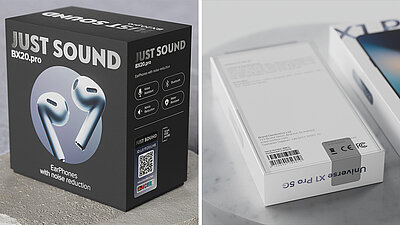The grey market – risks and countermeasures

Worldwide, technology products worth around 60 billion US dollars alone are sold through unauthorised channels each year1. According to a study by KPMG, more than 60 percent of the companies surveyed have seen an increase in grey market activities in recent years. A full 90 percent have already discovered their products on the grey market that were sold there without their consent.
In contrast to counterfeits, i.e. the deceptive imitation of branded products, the grey market offers genuine products that are produced by the original manufacturer, then illegally diverted and sold without their knowledge.

Grey market examples
A trader from a low price country buys a product at low cost, sells it in a high price country and thus achieves a higher trade margin. This trade margin is lost to the actual producer. In addition, the price level of the high price country collapses.
Sometimes, a product is not made available for strategic reasons. The grey market trader buys this product in the country of production and sells it abroad without authorisation, and without being bound by price specifications.
A product is no longer available in the destination country due to high demand. The grey market trader purchases the product (often in large quantities) in other countries and sells it, usually at much higher prices, in the destination country.
How to spot grey market products
Identifying grey market products can feel like navigating a labyrinth, but knowing what to look for can simplify the task. Here’s how you can determine if a product is part of the grey market by examining price discrepancies, sales channels, and documentation.
1. Look Out for Price Discrepancies
Grey market goods often come with prices that are significantly lower—or occasionally higher—than what you’d find with authorized retailers. If a product is available at a price that seems too good to be true, especially when it diverges from prices at well-known stores like Amazon or Best Buy, it's worth being cautious. These price differences happen because the products might bypass the standard distribution channels.
2. Examine Unusual Sales Channels
Notice where the product is being sold. Legitimate, authorized products typically stick to official stores or trusted online platforms. If you come across products sold through unconventional channels—perhaps an unfamiliar e-commerce site or sellers without brand authorization—it’s a sign to turn your buyer’s radar on. These sellers might lack the proper channels to ensure authenticity and warranty support.
3. Scrutinize Documentation and Packaging
Documentation can reveal a lot about the legitimacy of a product. Grey market goods might have incomplete, incorrect, or missing documentation, such as user manuals or warranty cards. Check that all serial numbers and manufacturing information on the packaging match the product inside. Differences or inconsistencies may indicate that the product didn’t follow the legal route to market.
Additional Red Flags
Inconsistent Product Identifiers: If serial numbers, manufacturing dates, or batch codes are inconsistent, the product might be grey market or counterfeit.
Consumer Reviews and Complaints: A surge in negative feedback regarding product functionality, warranty claims, or compatibility issues can also suggest a grey market presence.
Staying vigilant for these signs can help you avoid the pitfalls of purchasing grey market products, ensuring you get the quality and support you deserve.
Successful action against the grey market from practice
The cigarette manufacturer Philipp Morris was able to stop the unauthorised import of Marlboro cigarettes and other brands via the grey market, because the cigarette packets did not carry a warning in the local language and were therefore not legally compliant with the local market.2
Kanebo, a manufacturer of luxury cosmetic products, successfully defended itself against the sale of its products in German retail chains via grey market
imports. Above all, their product placement next to generic, mass production products was harmful as it did not clearly differiantiate the value of the product.3
Red Bull also had to deal with unauthorised grey imports into foreign markets. Above all, the soft drink manufacturer complained that the formulations and ingredients of the drink differed from country to country, and that it was therefore not universally tradable.2
The risks of the grey market
Unauthorised trading of products on the grey market is a serious problem for many companies, as it threatens both loss of revenue and lasting damage to their reputations.
In addition to significant revenue losses that companies have to suffer due to grey market sales or costly countermeasures, there are numerous other side effects that the grey market brings with it.
Disadvantages for OEMs (Original Equipment Manufacturers)
- For many products, customer service is an important source of revenue. This is often omitted or associated with difficulties in the case of grey market products.
- Dissatisfaction of end customers caused by a product purchased on the grey market falls back on the company.
Disadvantages for authorised distributors
- Due to possibly more favourable prices when sold by grey market dealers, authorised dealers are pushed into the background.
- Authorised distributors’ reputations are affected by unauthorised grey market dealers.
Disadvantages for end consumers
- Missing or foreign-language instructions or descriptions cause frustration during commissioning or use of the product.
- Guarantee or warranty claims cannot be made, as grey market products do not contain them.
Special challenges for OEMs
OEMs are struggling with the effects of the grey market; for example, through price dumping and extraordinary discounts from grey market dealers, through additional service costs for end customers caused by product handling problems and a lack of warranty coverage.
The increase in grey market activity in recent years is challenging more and more OEMs and has led to numerous legal cases targeting unauthorised resales. In addition, more and more companies are focussing on effective monitoring and other measures that address grey market trade.

The role of copyright protection in combating grey market goods
Copyright protection plays a crucial role in the battle against grey market goods. These unauthorised items often use copyrighted materials such as text, images, or videos to mislead consumers into believing they are purchasing authentic products.
Here are some key ways copyright protection helps counter this issue:
Detection and Identification: By enforcing copyright laws, companies can require sellers to remove any copyrighted content. This removal makes it easier to detect and identify unauthorized goods masquerading as legitimate products.
Protect Brand Integrity: Copyright protection ensures that only authorized dealers can use genuine content. This prevents grey market sellers from leveraging brand recognition to deceive customers.
Legal Recourse: Companies can take legal action against those who use copyrighted materials without permission, discouraging the distribution and sale of grey market goods.
Consumer Awareness: By removing misleading content, copyright protection helps consumers make informed decisions, reducing the risk of inadvertently supporting grey market activities.
In essence, copyright protection serves as a defensive tool, safeguarding both brands and consumers from the pitfalls associated with grey market goods.
Measures to combat grey market activities
What can OEMs do to reduce or even prevent grey market activities? We have summarised the most important measures and how we can support you in implementing them.
1. Take responsibility
Create a responsible position in your company, for example, in a Brand Protection Department, that coordinates your measures and activities. These range from internal and external communication to the training of employees and partners to the development of guidelines for distributors that help to sanction violations and create incentives to stay away from the grey market.
2. Apply a copy-proof marking solution
To ensure the long-term protection and traceability of your products, it is advisable to use a marking solution that cannot be copied. The following criteria are important, which we guarantee with our products:
- The security technology used is not freely available on the market.
- Each security marking is unique and can be authenticated at any time.
- The solution combines overt and covert security features.
- The security feature is protected against manipulation and removal.
3. Use constant monitoring
Our grey market service with cost-effective, intelligent track & trace immediately detects when a product shows up in a region where it doesn’t belong. To activate this feature, you simply have to specifiy in our digital platform which regions you ship to and which distributors are responsible for which areas. Each of our labels indicates the destination of the retailer's products. This information is then cross-checked with the end customer's geodata during the final product scan, which we incentivize to carry out. In case of a mismatch, you will be instantly notified.
4. Raise awareness on the topic
Grey market activity should not be taken lightly, as it can cause massive damage to your company, both in terms of your reputation and financially. Therefore, it is even very important that you inform and sensitise both your employees and your partners about the issue. Together, you must ensure that your products reach the end consumer legally and in their original condition.
How cross-sector collaboration curbs grey market goods online
Cross-sector collaboration is pivotal in tackling the issue of grey market goods in the digital marketplace. By bringing together diverse industries, businesses can share unique insights and strategies to combat this growing problem. Here’s how this collaborative effort makes a significant impact:
1. Diverse perspectives foster innovation
Working with partners from various sectors provides a broader understanding of the challenges at hand. This diversity fosters innovative approaches to counteracting grey market activities, as each sector brings distinct strengths and experiences to the table.
2. Industry roundtables for knowledge exchange
Facilitating industry roundtables and other collaborative events allows companies to discuss and dissect common challenges. Through these gatherings, businesses can learn effective practices from one another, helping to create a unified front against unauthorized sales channels.
3. Building stronger networks
Collaboration enhances communication and trust among industry players.
By creating stronger networks, companies can quickly and effectively share updates about new tactics being used in grey markets, enabling faster and more coordinated responses.
4. Joint development of technological solutions
Pooling resources for technological advancements is another powerful aspect of cross-sector collaboration. Joint development of software and tools can lead to more robust systems for monitoring and intercepting grey market goods online.
5. Advocacy and policy influence
A unified voice in advocacy can be more persuasive in influencing policy changes. When multiple industries unite, they hold greater sway in encouraging governments to implement stricter regulations and enforcement mechanisms against grey market activities.
In summary, by leveraging the collective expertise and resources of various sectors, cross-sector collaboration not only addresses the immediate problem of grey market goods but also strengthens the entire marketplace against future threats. This cooperative strategy creates a more secure and trustworthy online environment for consumers and businesses alike.
5. Educate end customers
To ensure the effectiveness of monitoring, the cooperation of the end customers is indispensable. Incentives, such as discounts or competitions, can significantly increase the end customers' willingness to scan. However, it is also important to make clear the dangers posed by the grey market, as well as to communicate the many other advantages that the end consumer receives by purchasing an original product through a regular distribution channel. Since the product features of our security solutions cannot be imitated, they quickly become an integral part of a product or outer packaging that the consumer would miss should they be removed. At the same time, transparent communication about product tracking deters any grey market traders.
Our offer: We also take over the design of the communication of the end consumer and the distributors, dealers etc. for you. We would be happy to make you a suitable offer!
6. Motivate cooperation
In addition to the continuous monitoring and review of distribution channels, it is a good idea to involve distributors, dealers and other partners in order to identify weaknesses. Incentives can also be used here to motivate all those involved to cooperate. And here as well, we have the right solutions for you.
Sources:
1 https://www.financierworldwide.com/how-manufacturers-can-combat-the-grey-market#.YSdFDd9CSUk
2 https://businesslawtoday.org/2019/07/combating-gray-market-goods-using-itc-solve-gray-market/




